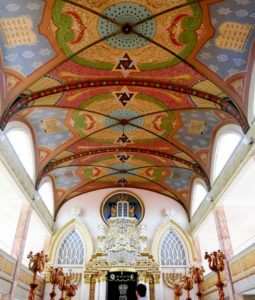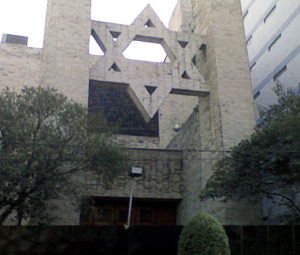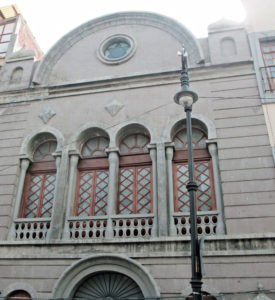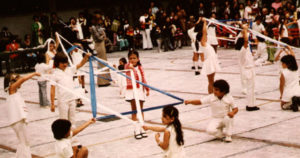 Crypto-Jews arrived in Mexico as early as 1521. By 1550 almost 25% of Mexico City’s Spanish population was known to be Jewish, and the community had its own Grand Rabbi. The number might have been even larger, since many Jews disguised themselves as Catholics. Many of them had fled Spain to escape the Inquisition, but this was still in place in Mexico until 1820, thus Jews needed to remain hidden. One hidden Jewish community was Venta Prieta.
Crypto-Jews arrived in Mexico as early as 1521. By 1550 almost 25% of Mexico City’s Spanish population was known to be Jewish, and the community had its own Grand Rabbi. The number might have been even larger, since many Jews disguised themselves as Catholics. Many of them had fled Spain to escape the Inquisition, but this was still in place in Mexico until 1820, thus Jews needed to remain hidden. One hidden Jewish community was Venta Prieta.
When the monopoly of the Roman Catholic Church in Mexico was replaced with religious toleration during the nineteenth-century, Jews could openly immigrate to Mexico. A number of German Jews settled in Mexico as a result of invitations from Maximilian I of Mexico, followed by a huge wave of Ashkenazic Jews fleeing pogroms in Russia and Eastern Europe. The immigrants were not allowed to become Mexican citizens, but their main challenges to living in Mexico were economic, rather than social or religious. In 1861, a group rented a hall to celebrate Rosh Hashanah and Yom Kippur, the first recorded instance of public Jewish worship. From 1864 to 1867, Maximilian invited some European Jews from France, Belgium, and Austria-Hungary to settle in Mexico.
 In the 1880s, Jews were entitled to Mexican citizenship and full integration and a significant wave of Jewish immigration began. The assassination of Czar Alexander II in Russia pushed Jews to leave the country. About half of Mexico’s Jewish population can be linked to this wave of immigration. Jewish immigrants in Mexico City built businesses and set up the country’s first Jewish cemetery.
In the 1880s, Jews were entitled to Mexican citizenship and full integration and a significant wave of Jewish immigration began. The assassination of Czar Alexander II in Russia pushed Jews to leave the country. About half of Mexico’s Jewish population can be linked to this wave of immigration. Jewish immigrants in Mexico City built businesses and set up the country’s first Jewish cemetery.
A second large wave of immigration occurred from the very late 19th century into the early 20th as the Ottoman Empire collapsed, causing many Sephardic Jews from Turkey, Morocco, and parts of France to flee. In 1900, the Mexican census counted 134 Jews in the country. Between 1917 and 1920 Jews began to come from Russia, Poland, Lithuania, the Balkans and the Middle East. Ten thousand Eastern Europe Jews arrived at the port of Veracruz. The rate increased in 1921 when the United States imposed quotas on its immigration. In the 1920s, the Jewish community grew and prospered in Mexico.
Most of the Jewish communities’ social and religious organizations were formally founded in the first half of the 20th century. These include the the first Jewish religious school (1917), the first federally recognized synagogue (1918), the Talmud Torá Hatihiá (1919), the Congregación Nidje Israel for Ashkenazi Jews (1922), the first Ashkenazi religious school (1922), the Har Sinaé synagogue for the Damascus Jewish community, (1923), the Centro Israelita and first synagogue in Monterrey (1923), the Colegio Israelita de México (1924), the Agudat Ajim community in Guadalajara (1923), the Bnej Kedem Sephardic community Centre (1926), the Nidje Israel Ashkenazi cemetery (1929), and the Colegio Israelita Hatikva in Monterrey (1932).
 The Jewish Central Committee of Mexico was formed in 1938 as a response to the situation for European Jews at that time. At first, its function was to help Jews escape from the Nazis but later became an umbrella organization for the various Jewish communities in Mexico. It also acted as a representative body for all Jews in Mexico with the Mexican government and other Jewish communities. A final wave of immigrants fled the increasing Nazi persecutions in Europe during World War II. Despite strenuous efforts by the Jewish community to rescue Jews from the Nazis, they had little success. Only 1,850 Jews from Poland, Russia, Germany and Austria were allowed to emigrate to Mexico. However, the Mexican government, headed by Lazaro Cardenas, was more than willing to look the other way and did so when some 200 Jews from Cuba entered the country illegally.
The Jewish Central Committee of Mexico was formed in 1938 as a response to the situation for European Jews at that time. At first, its function was to help Jews escape from the Nazis but later became an umbrella organization for the various Jewish communities in Mexico. It also acted as a representative body for all Jews in Mexico with the Mexican government and other Jewish communities. A final wave of immigrants fled the increasing Nazi persecutions in Europe during World War II. Despite strenuous efforts by the Jewish community to rescue Jews from the Nazis, they had little success. Only 1,850 Jews from Poland, Russia, Germany and Austria were allowed to emigrate to Mexico. However, the Mexican government, headed by Lazaro Cardenas, was more than willing to look the other way and did so when some 200 Jews from Cuba entered the country illegally.
From then until 1950, an estimated 7,300 Jewish people immigrated to Mexico from Eastern Europe, 2,640 from Spain or the former Ottoman Empire, and 1,620 from Cuba and the United States. These various Jewish groups formed their own religious congregations and social institutions. Turkish Jews began holding open religious services in 1901 and founded the first Talmud Torah in 1905, as an educational institution for boys. Ashkenazi Jews began holding open services as early as 1904. The first formal Jewish organization in Mexico, the Monte Sinaí community was founded in 1912. In 1940 the Jewish population stood at somewhat over 1,100.
 At the turn of the 20th century and the decades that followed, Jewish migration to Mexico hit record levels, with families arriving from Central/Eastern Europe, the Middle East and the Mediterranean, through the ports of Veracruz and Tampico. In the 1920s, the Jewish community in Mexico City centred around Jesús María street, but in the 1930s and 40s many Jewish residents moved to the leafy streetcar suburbs of Roma and Condesa, where Yiddish was the unofficial language of Parque México. Today, in the area, there is a Jewish museum, archives, synagogue, and kosher deli as well as, several more small orthodox synagogues hidden inside houses on Amsterdam Avenue, and another synagogue at the corner of Montes de Oca and Parral streets. In the 1950s, 60s, and 70s, Jews moved further west to Polanco, Lomas de Chapultepec, Interlomas, Bosques de las Lomas, and Tecamachalco, where the majority are now based. Jewish communities can also be found in Guadalajara , Monterrey, Tijuana, Cancun and San Miguel.
At the turn of the 20th century and the decades that followed, Jewish migration to Mexico hit record levels, with families arriving from Central/Eastern Europe, the Middle East and the Mediterranean, through the ports of Veracruz and Tampico. In the 1920s, the Jewish community in Mexico City centred around Jesús María street, but in the 1930s and 40s many Jewish residents moved to the leafy streetcar suburbs of Roma and Condesa, where Yiddish was the unofficial language of Parque México. Today, in the area, there is a Jewish museum, archives, synagogue, and kosher deli as well as, several more small orthodox synagogues hidden inside houses on Amsterdam Avenue, and another synagogue at the corner of Montes de Oca and Parral streets. In the 1950s, 60s, and 70s, Jews moved further west to Polanco, Lomas de Chapultepec, Interlomas, Bosques de las Lomas, and Tecamachalco, where the majority are now based. Jewish communities can also be found in Guadalajara , Monterrey, Tijuana, Cancun and San Miguel.
Today’s Mexican Jewish community is tightly-knit and contains several distinct strands: two separate Syrian communities thrive, each with their own traditions, from Aleppo and Damascus. Ashkenazi Jews maintain the traditions they brought with them from Eastern Europe. Another group of Mexican Sephardi Jews hails from the Balkans, and keeps those memories alive through family recipes and customs. Finally, a fifth group has made its mark on Mexico’s Jewish community in recent years: immigrants from the United States, who call Mexico home now and have brought their own distinct traditions from North of the Border to Mexico. Growing recognition of New Mexico as a place to retire led to the creation of such towns as Rio Rancho, which drew Jews from the northeast in the 1960s and 1970s.
 Intermarriage rates are among the lowest in the world: 94% of Mexican Jews marry other Jews. Approximately 95% of Mexican Jews are affiliated with the Jewish community, and about 95% of children attend one of the community’s sixteen different Jewish schools. In Mexico City, there are more than twenty synagogues, several Kosher restaurants and at least twelve religious schools where almost 80 percent of the Jewish youth receive their education. There are all kind of schools, from very religious, religious, Zionist, to secular. All of them teach Hebrew and English, and three teach Yiddish in addition to Hebrew. The Jewish schools are considered among the best in the Country.
Intermarriage rates are among the lowest in the world: 94% of Mexican Jews marry other Jews. Approximately 95% of Mexican Jews are affiliated with the Jewish community, and about 95% of children attend one of the community’s sixteen different Jewish schools. In Mexico City, there are more than twenty synagogues, several Kosher restaurants and at least twelve religious schools where almost 80 percent of the Jewish youth receive their education. There are all kind of schools, from very religious, religious, Zionist, to secular. All of them teach Hebrew and English, and three teach Yiddish in addition to Hebrew. The Jewish schools are considered among the best in the Country.
The schools are coordinated by the Vaad Hajinuj, which also supports the Hebraic University, where Jewish teachers are trained. All the schools provide scholarships for families, who cannot afford to pay tuition. About 30% of students currently receive some form of financial aid. The inter-marriage rate is around 6%, with 74% of those converted to Judaism, which brings the rate to around 2%.The population of Jews in Mexico, is estimated at 80,000-90,000 making them the third largest Jewish community in Latin America.